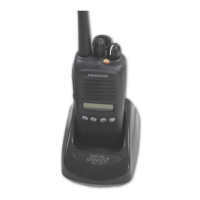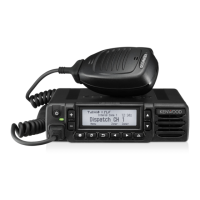
Do you have a question about the Kenwood NX-3320 K2 and is the answer not in the manual?
| Channels | 260 |
|---|---|
| Operating Voltage | 7.5V DC ±20% |
| Digital Protocol | NXDN, DMR |
| MIL-STD | MIL-STD-810 C/D/E/F/G |
| Operating Temperature | -30°C to +60°C |
| Power Output | 5W |
| Channel Spacing | 12.5 kHz/25 kHz |
| Modulation | 16K0F3E, 11K0F3E |
| Waterproof Rating | IP54 |
| IP Rating | IP54 |
Includes frequency range, channel capacity, channel spacing, power supply, and operating temperature.
Details receiver sensitivity, selectivity, intermodulation, and spurious rejection.
Details transmitter RF power output, spurious emission, and FM hum & noise.
Precautions for safe operation and handling of the transceiver.
Instructions for initial system setup and configuration of the transceiver.
Description of different operating modes for realignment and their functions.
Step-by-step instructions on how to access various transceiver modes.
Procedures for programming and interacting with the transceiver via a PC.
Guide to updating or programming the transceiver's firmware.
Instructions for cloning transceiver data between units.
Details on programming transceiver settings directly via the front panel.
Steps for writing configuration data to the transceiver using front panel programming.
General overview of the transceiver's circuit design and functionality.
Explanation of the transceiver's frequency configuration and signal flow.
Detailed description of the transceiver's receiver RF and baseband circuits.
Explanation of the audio amplifier circuit within the codec IC.
Detailed description of the transmitter's audio band, baseband, and amplifier circuits.
Explanation of the Automatic Power Control (APC) circuit.
Description of the Phase Locked Loop (PLL) synthesizer and its function.
Overview of the control circuit, including MPU/DSP functions.
Details on the low battery warning system and indicators.
Explanation of the Digital Signal Processor (DSP) functions and processes.
Description of the Bluetooth and GPS circuit components and functionality.
Detailed explanation of the Bluetooth circuit operation and frequency configuration.
Detailed explanation of the GPS circuit operation and frequency configuration.
Description of components used in the TX-RX unit.
Pinout and function description for various unit terminals.
Detailed specifications for the Speaker/Microphone connector.
Precautions for safe disassembly and maintaining waterproof integrity.
Step-by-step guide for disassembling transceiver components.
Procedure for removing the mechanical stopper on non-LCD models.
Step-by-step guide to detach the front case from the transceiver chassis.
Procedure for removing the holder ASSY from the main chassis.
Steps to remove the display unit from the transceiver chassis.
Procedure for removing the TX-RX unit from the transceiver chassis.
Instructions for carefully removing the top packing from the chassis.
Procedure for removing the terminal block with packing.
Steps to remove the stopper and circular nut for selector and volume knobs.
Important precautions to consider during the reassembly process.
Information regarding sheet and cushion replacement during assembly.
Controls and their functions specific to NX-3220(K, K2, K3) models.
Preparatory steps and equipment required for transceiver checking and tuning.
Details on entering and operating the panel test mode for K2 and K3 types.
Explanation of button functions available in panel test mode.
Information on transceiver frequencies and signaling adjustments.
Instructions for entering panel tuning mode and operating its functions.
Steps to enter the transceiver tuning mode and adjust settings.
Details on button operations within the panel tuning mode.
Procedures for adjusting frequency based on 5 or 9 reference levels.
Table listing adjustment items, their display names, and adjustment ranges.
Visual flowchart illustrating the panel tuning mode operations.
Identification of specific adjustment points on the TX-RX unit.
List of required test equipment and their major specifications for alignment.
Procedures for checking radio functionality and performance.
Common adjustment procedures applicable across different settings.
Procedures for adjusting and calibrating transmitter functions.
Procedures for adjusting receiver parameters like AF level, IQ phase, and RSSI.
Controls and their functions specific to NX-3220(E, E2, E3) models.
Details on entering and operating the panel test mode for E and E2 types.
Instructions for entering panel tuning mode and operating its functions.
Identification of specific adjustment points on the TX-RX unit.
List of required test equipment and their major specifications for alignment.
Procedures for checking radio functionality and performance.
Common adjustment procedures applicable across different settings.
Procedures for adjusting and calibrating transmitter functions.
Controls and their functions specific to NX-3320(K, K2, K3) models.
Details on entering and operating the panel test mode for E and E2 types.
Instructions for entering panel tuning mode and operating its functions.
Identification of specific adjustment points on the TX-RX unit.
List of required test equipment and their major specifications for alignment.
Procedures for checking radio functionality and performance.
Common adjustment procedures applicable across different settings.
Procedures for adjusting and calibrating transmitter functions.
Procedures for adjusting receiver parameters like AF level, IQ phase, and RSSI.
Controls and their functions specific to NX-3320(E, E2, E3) models.
Details on entering and operating the panel test mode for E and E2 types.
Instructions for entering panel tuning mode and operating its functions.
Identification of specific adjustment points on the TX-RX unit.
List of required test equipment and their major specifications for alignment.
Procedures for checking radio functionality and performance.
Common adjustment procedures applicable across different settings.
Procedures for adjusting and calibrating transmitter functions.
Procedures for adjusting receiver parameters like AF level, IQ phase, and RSSI.
Troubleshooting procedures for diagnosing and resolving transceiver faults.
Flowchart for diagnosing faults related to BGA ICs like MPU/DSP and memory.
Troubleshooting flowchart for diagnosing GPS function issues.
Troubleshooting flowchart for diagnosing Bluetooth function issues.
Diagnostic procedures for VCO circuit issues in NX-3220 models.
Diagnostic procedures for VCO circuit issues in NX-3320 models.
Instructions for performing enforced firmware overwriting on the transceiver.
Procedures and information for replacing the TX-RX unit.
Important precautions to consider when interpreting schematic diagrams.
Component side view of TX-RX unit (XC1-178K-00) and foil side view (J7C-0188-00).
Component side view of TX-RX unit (XC1-180K-00).
Component side view of Display Unit (XC1-209) with various connectors.
Foil side view of Display Unit (XC1-209) with component labels.
Block diagram illustrating the interconnection of major units in the TX-RX unit.
List of parts for the general assembly, including part numbers and descriptions.
Detailed list of all electrical components used in the TX-RX unit.
Continuation of the electrical parts list for TX-RX unit components.
Continuation of the electrical parts list, detailing capacitors.
Continuation of the electrical parts list, detailing resistors.
Continuation of the electrical parts list, detailing resistors.
Continuation of the electrical parts list, detailing ICs, transistors, diodes, and resistors.
Continuation of the electrical parts list, detailing capacitors.
Continuation of the electrical parts list, detailing capacitors.
Continuation of the electrical parts list, detailing capacitors.
Continuation of the electrical parts list, detailing resistors.
Continuation of the electrical parts list, detailing resistors and chip ferrites.
Continuation of the electrical parts list, detailing chip ferrites, filters, and connectors.
Continuation of the electrical parts list, detailing ICs, transistors, diodes, and resistors.
Continuation of the electrical parts list, detailing resistors and chip ferrites.
List of packing materials and accessories included with the transceiver.












